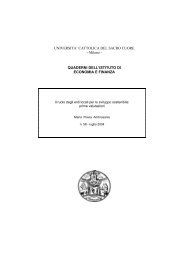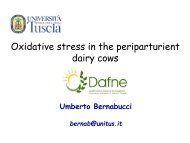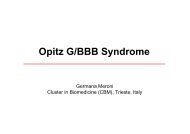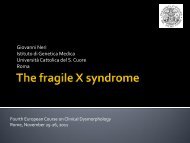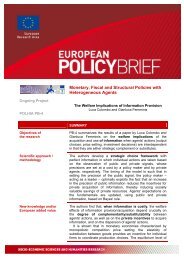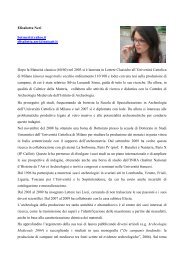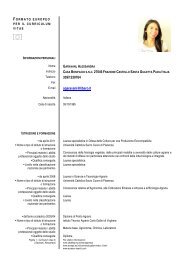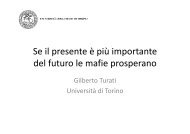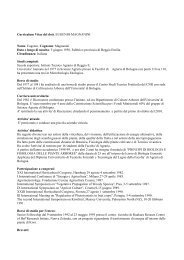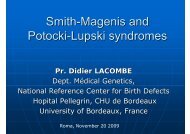UNIVERSITA' CATTOLICA DEL SACRO CUORE - Milano - Istituti
UNIVERSITA' CATTOLICA DEL SACRO CUORE - Milano - Istituti
UNIVERSITA' CATTOLICA DEL SACRO CUORE - Milano - Istituti
Create successful ePaper yourself
Turn your PDF publications into a flip-book with our unique Google optimized e-Paper software.
secondly, the suitability of the likely fragmented (vertically and horizontally)<br />
industry structure emerging during the initial phase (when service-based<br />
competition is promoted) to develop genuinely sustainable forms of competition<br />
based on the network without the need of pervasive regulation.<br />
Despite it is often claimed that network-competition through access regulation<br />
backed with accounting separation is the most proportional regulatory approach<br />
towards full liberalization, empirical evidence is not entirely consistent with this<br />
argument: it demonstrates that, on the one hand, heavy and intrusive regulation (as<br />
well as careful antitrust supervision) is needed to accompany the transition<br />
towards a genuinely competitive market and that, on the other hand, the incentives<br />
on the incumbent to engage in strategic behaviour, such as 3D strategy, are so<br />
powerful as to offset even the harshest threats of punishment by national<br />
Authorities. Hence, the claim that structural separation is unduly costly and<br />
unnecessary should be at least partly revisited, in the light of the less exciting<br />
performance of alternative solutions in the real world. Similarly, the applicability<br />
of what we defined as ‘evolutionary approach’ to network industry regulation has<br />
to be assessed.<br />
The effectiveness and the sustainability of this network-competition strategy are<br />
increasingly questioned in Italy and Europe: successful incumbent’s exclusionary<br />
conduct may hamper the competitive process up to the point that the ultimately<br />
desired market structure will not be achieved. In the light of the disappointing<br />
results of the liberalization process, several Tlc operators as well as independent<br />
authors and academics have called for a profound revision of the present<br />
regulatory framework, involving also (but not only) structural separation.<br />
Other authors, at the opposite, questioned whether such alleged poor performance<br />
of liberalization should indeed be interpreted as the only possible outcome, given<br />
industry characteristics. Nonetheless, the crucial point here is not what the natural<br />
market structure is: either a natural monopoly, or a natural oligopoly, or a<br />
dominant firm facing a competitive fringe, or a relatively perfectly competitive<br />
market. The real issue is how to enable the natural market structure (whatever it is<br />
in the real world) to emerge undistorted and how to make it as competitive as<br />
possible, thus eliminating perverse incentives for both abusive conduct and<br />
collusive behaviour.<br />
Under this perspective, the capability of the regulatory framework to promote and<br />
protect competition should be valued within the boundaries imposed by the<br />
natural tendency to concentration of the fixed Tlc industry. Bearing this in mind,<br />
we are still prepared to argue that vertical integration backed with access<br />
regulation and imposition of accounting and functional separation on Telecom<br />
Italia have performed quite poorly in Italy, and hence some radical alternatives<br />
merit to be considered.<br />
As a matter of fact, neither the Agcom nor the Agcm appear to deserve particular<br />
blame: just as every human activity, the Tlc regulatory process and antitrust<br />
enforcement may be improved (and actually have been improved over the years)<br />
and indeed some errors and inconsistencies may be found. Yet, the relevant point<br />
21




